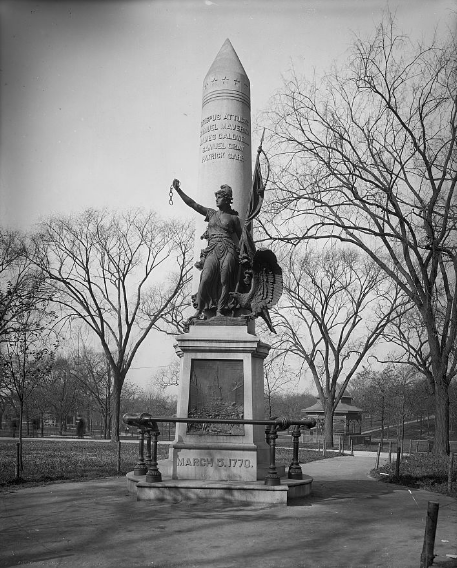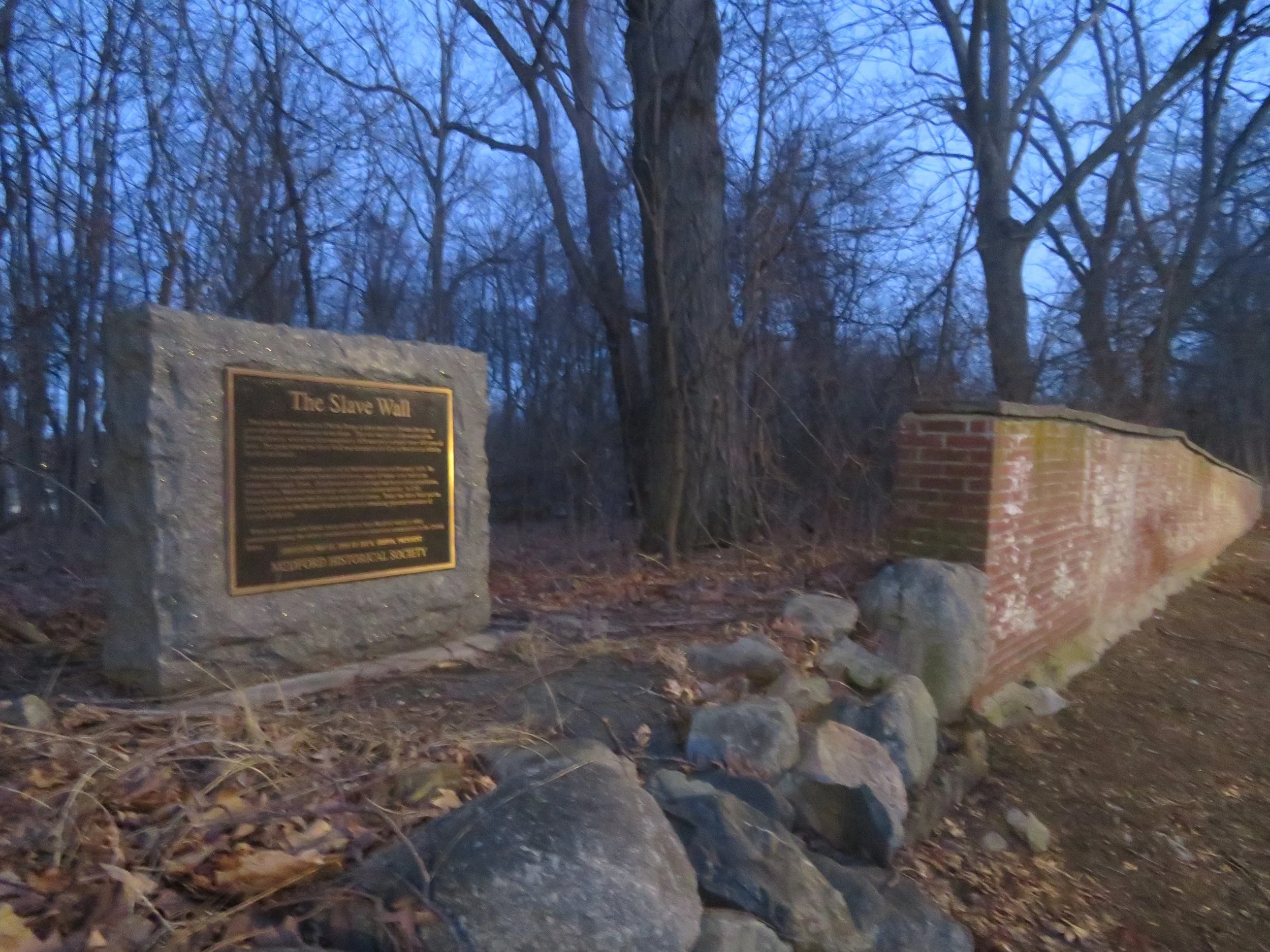
Boston Massacre Monument / Crispus Attucks
Boston Common, Tremont and Avery Sts.
Crispus Attucks (c. 1723 - 1770), a man of Wampanoag and African descent, was the first to fall at the Boston Massacre on March 5, 1770. Attucks was born in Framingham, west of Boston, and was possibly related to a Narragansett Indian, John Attuck, who was hanged during King Philip’s War (1676). While Boston-area abolitionists established a Crispus Attucks day during the 1850s, after the Civil War, African descended people across greater Boston campaigned for this memorial, which commemorates Attucks as well as those who died with him during the Massacre.
Detroit Publishing Company, c. 1900

Bunker Hill Monument
Bunker Hill Day, Charlestown, MA, c. 1900
Monument Sq., Charlestown, MA
During the American Revolution, nearly one out of every four soldiers in the Colonial Army were of African or Native American descent; African descended men comprised about a quarter of the British forces. At the Battle of Bunker Hill on April 19, 1775, 150 African descended soldiers were among the 3000 patriots who fought against the British. Some of these soldiers, like Prince Hall and George Middleton, went on to establish significant institutions for free African Americans across the North in the early days of the Republic. The monument was established in 1843.
Detroit Publishing Company, c. 1900

George Middleton / Louis Glapion House
5 Pinckney St., Beacon Hill, Boston, MA
During the early eighteenth century, Boston’s black community was concentrated in the current North End. With the end of the American Revolution, however, many African descended people migrated to the West End and the North Slope of Beacon Hill. In 1786, two free black men, George Middleton and Louis Glapion, began constructing a two-family wood structure on Pinckney Street. Completed in 1787, the house is the oldest-standing wooden structure on Beacon Hill and illustrates the deep roots of African Americans in the neighborhood. Louis Glapion lived here until his death in 1813 while his housemate, George Middleton, participated in some of his community’s first benevolent organizations, including the Boston African Benevolent Association and the African Lodge, later known as the Prince Hall Masons.
Tufts African American Trail Project

Long Wharf Dock & Custom House Block
Long Wharf Dock & Custom House Block, Boston, MA
The Long Wharf, completed in 1715, was one of colonial Boston’s central slave trading hubs. It was from this wharf, in 1637, that the "Desire" left the Northern Colonies with enslaved Pequot prisoners of war who were sold in the Caribbean. The ship then carried enslaved peoples of African descent to New England, returning to Boston in 1638. The Long Wharf’s history reveals that enslavement and the global slave trade expanded beyond rigid dualities of black and white, or African and European. Native Americans captured by colonists were often forced into slavery across the Atlantic world.
Boston Public Library

Pomp’s Wall / Brooks Estate
Grove St., Medford, MA
During the eighteenth century, Medford was home to two of the wealthiest slaveholding families in the region, the Royalls and the Brooks. Enslaved men, women, and children maintained the extravagant Brooks Estate, first settled in 1660 and occupied in 1679. Pomp, an enslaved man, built the Estate’s decorative entrance for slave owner Thomas Brooks in 1765. Although details about Pomp's life are scarce, the craftsmanship exhibited in the wall indicates the material and cultural value that enslaved people provided to the city.
Tufts African American Trail Project

Prince Hall Mystic Cemetery
52 Gardner St., Arlington, MA
Prince Hall (c. 1735 - 1807) was a veteran of the Revolutionary War, who demanded an end to colonial slavery through the Massachusetts General Court in 1777. In 1787, Hall founded the First African Masonic Lodge in the United States, an organization of community uplift and economic cooperation that spread throughout the United States and the world. In 1864, a local grandmaster of the Prince Hall Lodge, William Kendall, donated a parcel of his land on Gardner Street to African American Masons in the area. Used exclusively as a Masonic burial ground and public memorial until 1897, the cemetery was revitalized in the 1980s by local African-American resident, Samuel Lee Dance, and his fellow Masons.
Courtesy of Arlington Historical Society / Howard Winkler

Buckman Tavern / Prince Estabrook
Buckman Tavern c. 1933
1 Bedford St., Lexington, MA
During the American Revolution, people of African and Native descent fought on both sides of the conflict. Although Colonel George Washington initially prevented African descended people from serving in the Continental Army, many black men across New England joined local military companies that rallied in support of the Revolution. Some of these men were no doubt familiar with Buckman Tavern (est. 1709 - 1710), the first public house in Lexington, and a favorite gathering place for militia men during their training on the nearby Lexington Green. In 1773, an enslaved man, Prince Estabrook (c. 1741 - 1830) enlisted in the Lexington militia. Estabrook fought alongside his fellow colonists at the famous Battle of Lexington and Concord on April 19, 1775. Estabrook's story is memorialized on a plaque outside the tavern.
Detroit Publishing House

Royall House and Slave Quarters
Royall House and Slave Quarters c. 1907
15 George Street, Medford, MA
Isaac Royall Jr. (1719 - 1781), was one of the wealthiest slaveholders in colonial Massachusetts and an original financial supporter of Harvard Law School (est. 1817). As an Antigua slaveholder, Royall earned his fortune through the labor and sale of African men, women and children. One of these enslaved women, Belinda Royall Sutton, filed one of many freedom suits submitted by Africans across Massachusetts after the Revolutionary War. The slave quarters, adjacent to the Royall House, are one of the oldest extant slave dwellings still standing in the North.
Courtesy of Royall House and Slave Quarters, 1917

Massachusetts Historical Society
Massachusetts Historical Society
“The Historical Society” was founded in 1791 by ten Bostonians. Today, the
Massachusetts Historical Society is “the oldest organization in the United States devoted to collecting materials for the study of American history.” The Society’s vast collections include materials relating to slavery, abolition, and the Civil War, including the poems and letters of Boston’s Phillis Wheatley, the enslaved poet who wrote the first published book of poetry by an African American writer.
Courtesy of Massachusetts Historical Society








